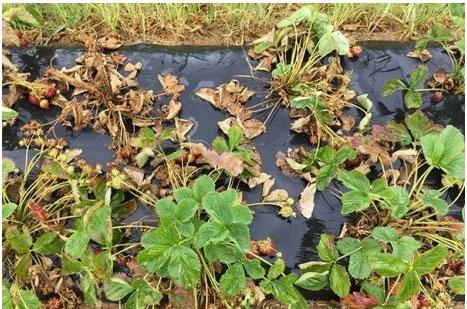
Figure 1. Plant collapse and bluish-green leaf color of 'Flavorfest' plants affected by Phytophthora crown rot. Photo: Kathy Demchak, Penn State
The production of strawberry plugs involves multiple stages during which pathogens can infect the plug plants before they are distributed to growers.
Despite regular scouting by propagators, and chemical sprays applied to avoid diseases, these infections can sometimes be latent and asymptomatic (i.e., they are present in the plant material, but there are no outward symptoms), making them a challenge to identify and manage.
Furthermore, cultivars currently grown vary in susceptibility to different diseases, with some being very susceptible to certain ones. Often inoculum is already present in growers’ fields where strawberries had been grown previously, and if a cultivar with certain susceptibilities is planted there, disease symptoms can rapidly develop, especially if plants are stressed during the planting process. The following are some steps you can take to minimize disease issues once strawberry plug plants are on your farm.
General: All Diseases
Remove any leaves with symptoms and all runners while the plants are still in their trays, starting with the cleanest-appearing trays. Watch for brown blotches on leaves and brown sunken lesions on petioles in particular. Collect and dispose of this material. If you cannot complete this operation before you plant, do so right afterwards, and remove this foliage from the field. Diseases sporulate on plant tissue even after it is removed, so dropping plant tissue in the row middles does not eliminate the problems – though this is an improvement over doing nothing. Wash hands and tools frequently, or use hand sanitizer, as diseases can be moved from plant to plant on hands, clothing, and tools.
Do not plant any plug plants that are wilted and fail to recover quickly once watered. More information on specific diseases is given below. Always refer to product labels for use directions and check your state’s regulations to make sure that products may be used as specified in your location.
Phytophthora crown rot (aka Phytophthora crown and root rot)
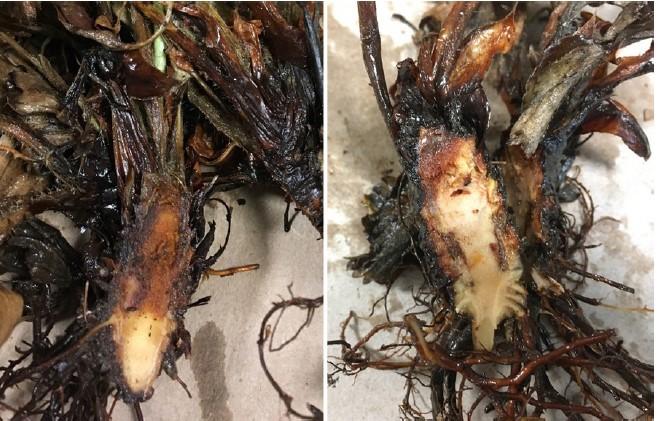
Symptoms consist of complete plant collapse in the fall and/or spring. Collapsing plants show a reddish-brown discoloration to the crown that is sharply delineated from healthy tissue, though eventually the entire crown may be affected. 'Flavorfest' seems especially susceptible to Phytophthora crown rot, as are some cultivars grown mostly in matted-row production.
Historically, this disease has been caused by specific "pathotypes" of Phytophthora cactorum which differ from the ones causing leather rot and is a different species from the one causing red stele (aka Phytophthora root rot) to which Flavorfest is thought to be resistant. Phytophthora crown rot affects certain cultivars much more than others. With other diseases caused by Phytophthora, tolerant cultivars, which can be infected but just don’t show symptoms, may still release inoculum of this disease into the soil from their roots. Whether that is the case with this disease is unclear. Work is underway to better understand current instances of disease occurrence in the mid-Atlantic region.
There have been striking differences in 'Flavorfest' performance in grower fields in that it has been extremely vigorous and high yielding in fields that never had strawberries grown in them before, but plants collapsed and died in fields where intervals between strawberry plantings were short, leading to the question of whether the Phytophthora crown rot organism had been introduced to the fields in earlier plantings. Exactly how long this disease can persist in a field is not known, but at least one other Phytophthora species can persist for six years.
When planting 'Flavorfest', and also 'Sweet Charlie', use fields that have never been used for growing strawberries if possible. At planting, use a plant dip of fosetyl-Al (Aliette WDG) or a phosphite product (ProPhyt, Phostrol, etc.). Make foliar applications through mid-Fall at intervals allowed on the label. The fungus is thought to become inactive later in the fall when temperatures cool. Watch for symptoms next spring and continue to treat. Ridomil (mefenoxam) has been very effective in some trials, but resistance has been reported, leading to reduced efficacy in some situations.
Trials conducted in California have shown that one plant dip of Aliette followed by five foliar applications with Aliette increased marketable strawberry yield approximately 40-60% compared with a water-only spray control in P. cactorum infested plants, whereas little difference was observed among those treatments in the non-infested control plants. Comparable results were also observed for the Ridomil soil drench treatment at planting (one application) and during the growing season (two applications). In a nutshell, these materials including phosphites and MetaStar can effectively manage Phytophthora. Compared to fosetyl-Al (Aliette) and phosphites, Ridomil poses a higher risk for resistance development. Whether to use these materials as a precaution depends on cultivar susceptibility, site and disease history, etc. Actigard is also labeled for suppression of phytophthora crown rot, but it is used as a foliar spray and cannot be applied within five days of transplanting. However, little data is available regarding its efficacy.
Anthracnose crown rot
With this disease, plants fail to grow as expected, and may eventually die. Upon close examination, you may find that the main crown has died, but branch crowns have started to grow. No cultivars are completely immune, but some such as 'Chandler' are very susceptible. Affected crowns appear firm and reddish-brown when they are sliced open. Crown tissue may be uniformly discolored brown, and symptoms sometimes can be confused with those from other crown rot issues.
Switch and Abound plant dips have been found to help with anthracnose crown rot control. Refer to the label for instructions. Two or three applications of captan or thiram may be made after planting during the fall season at 10- to 14-day intervals. Other products are also labeled for this use including Quadris Top, Protocol, and Topsin M. Note that widespread resistance in this pathogen has been found to Topsin M and other fungicides in the same FRAC groups (i.e., groups 1 and 11).
Neopestalotiopsis crown and fruit rot
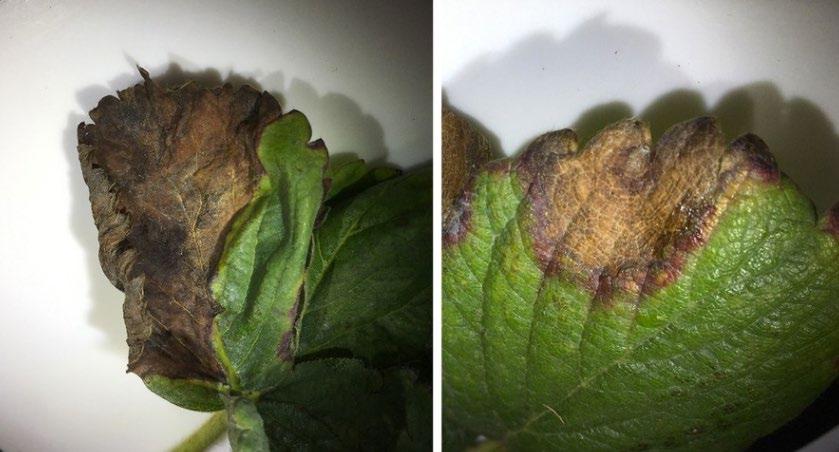
There are various strains or species of Neopestalotiopsis that cause different symptoms ranging from slowly progressing foliar symptoms to rapid plant decline and death. Early symptoms appear on leaves and consist of tan to brown roughly V-shaped lesions that are wider at the edge of the leaf. If the more virulent strain is present, large areas of the leaf are invaded in a matter of a few days with pycnidia (tiny black raised dots) appearing in the lesions shortly thereafter. The disease can also invade the crown and kill plants, and causes fruit rot similar to anthracnose fruit rot.
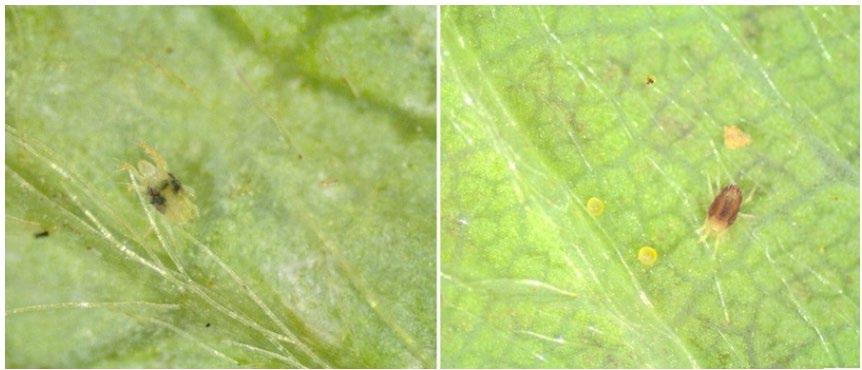
Many cultivars seem to be susceptible or at least bear watching. At planting and throughout the fall, remove any leaves showing disease symptoms. Sprays of Thiram and Switch (or Miravis Prime, containing fludioxonil as in Switch) 7 to 10 days apart can reduce the disease by about 40% more-or-less based on trials conducted in Florida. Other materials showed little efficacy against this disease. Though this disease caused some plantings in warm locations to be lost during the fall of 2020, the disease did not appear to persist into the spring of 2021 in northern locations. Whether that will be the case every year is not known. Interestingly, a recent study suggests a correlation between spider mites and high severity of Neopestalotiopsis. An insecticide or miticide spray may therefore be important to managing this disease if mites or other insects are of concern.
Powdery mildew
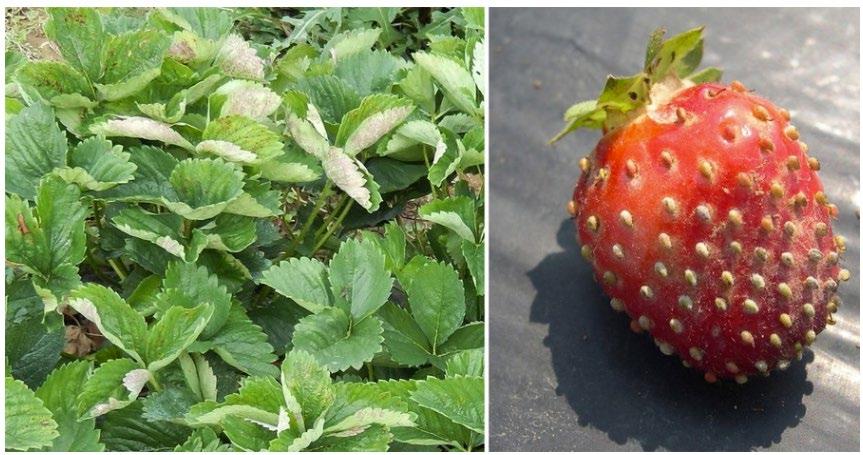
This disease lives on the surface of the plant tissue and causes leaf edges to curl inward. Reddish-purple blotches appear on the leaves and may coalesce and cause areas of the leaf to die, though the mildew on the leaves is usually apparent only in high tunnels or greenhouses.
'Flavorfest', 'Galletta', 'Earliglow' and any California-bred day-neutral cultivars, especially 'Seascape', are very susceptible. Fungicides in categories 3, 7, and 11, or specific “powdery mildew” fungicides such as Quintec and Torino are effective, while others are not. Note that powdery mildew resistance to many of these materials has been reported, but is neither frequent nor widespread yet. Usually, fungicides are not needed for this disease alone in the fall on plug plants, so sprays should be avoided in order to avoid the unintended consequences of developing resistant botrytis and anthracnose strains while treating the powdery mildew, as these products may be needed in the spring.
Angular leaf spot

This is a bacterial disease that is usually noticed in the spring because it causes caps to turn brown but is mentioned here because if the infection is severe enough, the bacteria can invade the plants' vascular systems causing them to collapse, and thus could be confused with other causes of plant collapse. The bacteria are splashed around by water and unlike most other diseases, this one thrives under cold temperatures. In years where long periods of overhead irrigation for frost protection are needed, it can become very widespread, resulting in tissue death that could be mistaken for fungal diseases.
Some newer cultivars grown in plasticulture appear to be quite susceptible. Since this disease is caused by a bacterium and not a fungus, copper-based materials are needed instead of standard fungicides (which have no effect) and should be applied in the spring to protect healthy foliage and berry caps from disease spread. Make these applications only if the disease is known to be present, as phytotoxicity can occur with multiple applications and when drying conditions are prolonged. It is unlikely that any spray applications will be needed for this disease in the fall. In addition, Actigard, which induces the plants’ systemic activated resistance, provided some control efficacy based on trials conducted in Florida. Note that Actigard should be applied at the lowest label rate. Higher rates were found to reduce yields.
Long-Term Steps to Take
With the exception of Phytophthora, the diseases mentioned above do not survive very well without plant tissue to survive in or on – which includes mummified crowns that can persist for at least 3 years. Beyond the control measures mentioned above, if diseases cannot be gotten under control, consider plowing down the worst sections of the field, and do not carry over the planting for a second harvest year. Second-year yields are likely to be low, disease pressure is more likely, and the chances of risking a future planting in the same field or other nearby plantings are increased.
This article appears on September 9, 2021, Volume 12, Issue 6 of the Vegetable and Fruit News
Vegetable and Fruit News, September 2021, Vol. 12, Issue 6
Vegetable and Fruit News is a statewide publication for the commercial vegetable and fruit industries and is published monthly during the growing season (April through October). Subscribers will receive an email with the latest edition.
Subscribe